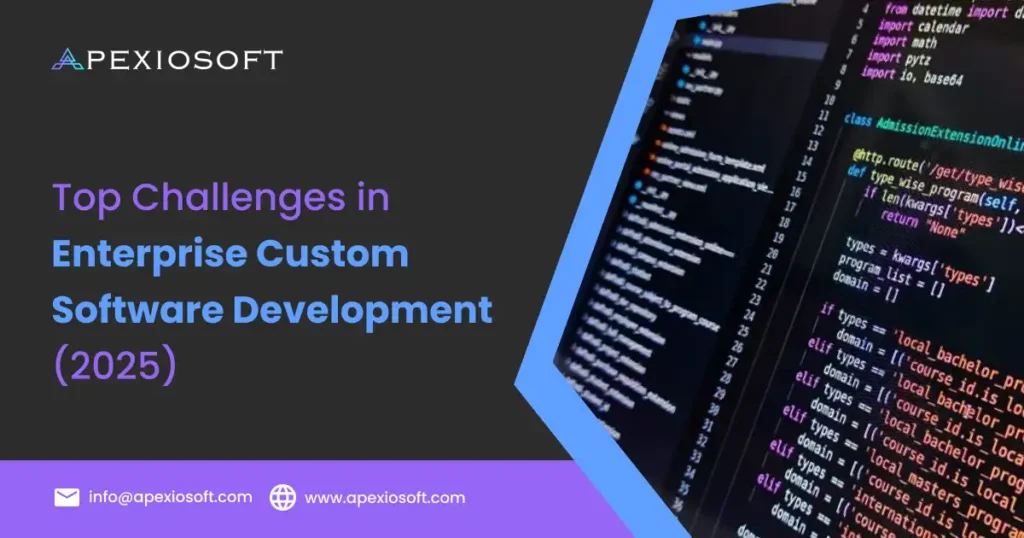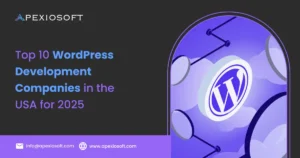TL;DR – Enterprises that treat custom software as a core competency will out‑innovate rivals. The biggest blockers in 2025 are: scope creep, talent scarcity, security & governance, legacy integration, budget overruns, and change management. Apexiosoft’s Lean‑Agile, DevSecOps, and hybrid delivery pods mitigate each risk, fast‑tracking ROI.
What Counts as “Enterprise” Custom Software?
Enterprise custom software is not a glorified departmental app. It must:
-
Serve thousands of concurrent users with 99.9 %+ uptime.
-
Integrate with core systems that may date back 20+ years.
-
Survive audits across GDPR, HIPAA, SOX, PCI‑DSS.
-
Encode competitive business logic that off‑the‑shelf suites can’t match.
Analysts note that 75 % of AI and software initiatives stall because underlying data and integration complexity isn’t solved first TechRadar. Thus, architecture, governance, and change‑management decisions sit squarely in the C‑suite, not just IT.
The 10 Hardest Challenges in 2025
1. Scope Creep & Stakeholder Politics
Multiple business units = multiple “must‑have” requests. Academic research shows scope creep directly correlates with schedule slippage and cost overruns Academia.
2. Legacy & Multi‑Cloud Integration
Mainframes without modern APIs, SaaS platforms with throttled endpoints, and multi‑cloud event streams create brittle coordination points.
3. Talent Shortage and Wage Inflation
U.S. unemployment for senior cloud engineers remains under 2 %. Salary bands climbed 15–25 % YoY Cloudurable.
4. Security & Compliance Debt
Zero‑trust mandates, ransomware threats, and evolving regulations (GDPR fines now exceed €2 billion cumulative) put CISOs on edge.
5. Budget Overruns & ROI Visibility
Analysts rank software cost overruns among the top three unanticipated enterprise expenses Metova.
6. Selecting, and Sticking to, the Right Tech Stack
Java, .NET 8, Python, Go, Rust, Kotlin… Each has trade‑offs in talent availability, performance, and vendor lock‑in. Enterprises often pivot mid‑stream, compounding risk.
7. Quality Assurance at Enterprise Scale
Testing microservices, data pipelines, and mobile front‑ends under real‑world load requires heavy automation and observability.
8. DevSecOps & Release Automation
Without policy‑as‑code and end‑to‑end CI/CD, release cadences slow from weeks to months, killing agility.
9. Change Management & User Adoption
Even flawless software fails if sales, support, and ops teams resist new workflows.
10. Ongoing Evolution & Technical Debt
Post‑launch, teams face feature drift, library CVEs, and shifting business priorities—without proper governance, technical debt snowballs.
Strategic Solutions & Apexiosoft Best Practices
1. Lean‑Agile Governance to Tame Scope
| Apexiosoft Practice | Impact |
|---|---|
| Single Product‑Owner Quorum | Consolidates decision authority; reduces re‑work. |
| Time‑boxed discovery spikes | Validate new ideas without derailing sprints. |
| Change‑control charter | Adds just‑enough formality; keeps flexibility. |
2. Integration Architecture Patterns
-
Event‑driven adapters decouple legacy systems.
-
Data virtualization exposes canonical APIs without massive ETL.
-
Service Mesh gives zero‑trust, multi‑cloud communication.
Result: 30 % faster integration timelines on average, according to internal benchmark projects.
3. Hybrid Delivery Pods Solve Talent Gaps
Apexiosoft operates USA on‑shore leads with near‑shore Latin‑America pods, offering 24‑hour sprint velocity while retaining English‑speaking domain expertise. Insights from North‑American talent reports show this model out‑competes pure off‑shore on quality while meeting budget constraints resources.stottandmay.com.
4. DevSecOps Pipeline
-
IaC + Policy‑as‑Code (Terraform + Open Policy Agent).
-
Shift‑left SAST/DAST—security tests run every PR.
-
SBOM generation for software supply‑chain peace of mind.
5. Predictive Budgeting & ROI Dashboards
Using Earned Value Management plus Story‑point throughput analytics, Apexiosoft gives CFOs real‑time burn‑up charts to prevent surprises.
6. Tech‑Stack Selection Framework
| Criterion | Weight | Scoring Dimensions |
|---|---|---|
| Ecosystem Maturity | 30 % | LTS roadmap, community size |
| Performance | 20 % | P99 latency, throughput |
| Talent Availability | 20 % | Market salary benchmarks |
| Cloud‑Native Fit | 15 % | Container/image size, cold‑start |
| Compliance & Security | 15 % | Encryption libs, audit tooling |
An early workshop scores each option, locking decisions before code is written.
7. Enterprise‑Grade QA
-
Contract testing for microservice interactions.
-
Chaos engineering to validate resilience.
-
Synthetic monitoring deployed pre‑launch.
8. Change‑Enablement Program
-
“Train the trainer” model for super‑users.
-
Embedded UX research to fine‑tune workflows.
-
Incentivized OKRs so adoption metrics matter company‑wide.
9. Continuous Evolution
Apexiosoft offers SaaS‑style maintenance SLAs: quarterly refactoring sprints, library upgrades, and automated CVE patching keep technical debt under control.
Future Trends Shaping 2025‑2030 Roadmaps
-
Generative‑AI Pair Programming – 35 % of enterprise code commits may be AI‑assisted by 2027 Hudasoft.
-
Composable Enterprise – Packaged Business Capabilities (PBCs) replace monolith ERPs.
-
FinOps for Software – Cloud cost observability embedded at sprint level.
-
Sovereign Cloud Zones – Regional data‑residency demands spawn multi‑tenant isolation frameworks.
-
Edge & IoT Security Meshes – 5G and sensor proliferation push policy enforcement away from the core.
FAQ
Why not just buy an off‑the‑shelf platform?
Generic suites rarely capture proprietary workflows that differentiate your brand. Custom builds embed your secret sauce and integrate cleanly with existing data.
Which programming language is best for large‑scale custom apps?
There’s no one‑size‑fits‑all. Java/Spring Boot, .NET 8, and Go remain enterprise favorites, but the “best” choice depends on performance targets, talent pool, and existing infrastructure.
How long does a typical enterprise build take?
Apexiosoft delivers MVPs in 5–6 weeks, with full production hardening in 1–2 months, depending on scope and integration depth.
What’s the ROI timeframe?
Clients usually see operational savings or new revenue streams within 12 months of go‑live through workflow automation, reduced license fees, or faster product releases.
Conclusion
Enterprise custom software development in 2025 is a high‑stakes arena where scope, security, talent, and tech choices make, or break, digital transformation. Apexiosoft’s battle‑tested frameworks, hybrid talent model, and DevSecOps discipline turn those obstacles into competitive advantage.
Contact us now!


